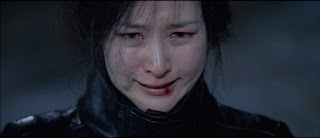listening: feeling the string tension
Towards the end of Chan-Wook Park’s Lady Vengeance (Chinjeolhan Geum-Jassi) there’s a forty second close-up of the main character. It’s an extraordinary scene in which you see the face of the main character (played by Yeong-ae Lee) crumple and contort, hovering uneasily between expressions of despair (mourning, perhaps?), relief, triumph, and half a dozen undefinable, unspecifiable states. It’s extraordinary also because, as you watch the scene progress, you can almost feel her muscles working under her face. It’s as if your face (not your eyes, not your brain) is responding to the scene; telling you what is happening, what to feel, how to empathize.
It’s an extraordinary scene in which you see the face of the main character (played by Yeong-ae Lee) crumple and contort, hovering uneasily between expressions of despair (mourning, perhaps?), relief, triumph, and half a dozen undefinable, unspecifiable states. It’s extraordinary also because, as you watch the scene progress, you can almost feel her muscles working under her face. It’s as if your face (not your eyes, not your brain) is responding to the scene; telling you what is happening, what to feel, how to empathize.
Listening to the radio last night and MLM asked if I could identify the type of guitar by ear. Well, beyond the obvious, all I can identify is a cloud of possibilities—probable combinations—that might be deployed to get a certain sound. The obvious: acoustic/electric, nylon/steel strings, finger/plectrum, etc. The probable: how its mic’d-up, pickups used, recording technologies, etc.
What surprised me, however, was that I could hear the string tension. Actually, scratch that, I could feel the string tension. On the guitar of a track on the radio, for example, I could feel that the strings were of higher tension than what I’m used to: an acoustic guitar with probably a higher action, maybe heavier strings. Later, listening to a recording by Bill Frisell, I could tell that he has much lower string tension, on the electric, than I do (even though Frisell tends to tune slightly sharp of Concert): Frisell probably uses lighter strings.
The funny thing is, it really is (almost) a bodily reaction—feeling the string tension—it does register in my fingers, arm, etc. (MLM, being a vocalist, has analogous reactions to recorded voices.) And, like watching that shot in Lady Vengeance, I know—I think I know—that it must be my sensory and cognitive mechanisms (ears-nerves-brain), that is constructing this model, but the (empathetic?) effects seem to be in my sinews and my muscles.
Does anyone else have similar responses? And does it seem to register in your body?


3 comments:
Have you been reading Wilhelm Reich?
Do we hear with our whole body, or is that just some new age jibba-jabba?
Very interesting thread my friend!
Interesting! "Knowing" things like string tension might be an interpretation of the input delivered to you by mirror neurons . Some other interesting reads:
neuroscience abstract
neuroscience article
sjz, Bas,
Thanks for the comments, and apologies for not replying sooner.
sjz, no I haven’t been reading Reich (other than the snippets from your (mis)readings). Anything to recommend in particular as begin pertinent to the issue of corporeal listening?
Yes, it could all end up too easily as ‘new age jibba-jabba’, but the question is, can we theorize this—orgone or no orgone—in a way that doesn’t end up that way—that is useful, or compatible, with performance?
Bas, yes, thanks for bringing up mirror neurons and the citations. A friend of mine did an very interesting presentation based on mirror neurons and corporeal listening. It strikes me, however, that there’s a higher-level enculturated listening going on here, and the question is, can we talk about this without recourse to the Neo-Cartesian mind-body split?
I also want to avoid the specter of the pre-cultured body—a ‘rosetta stone’ to use Susan McClary’s metaphor—and I want to acknowledge the possibility of misunderstandings.
Thanks again for the comments.
S, tig
Post a Comment